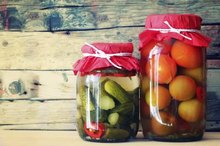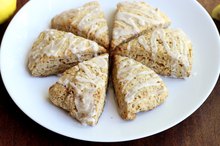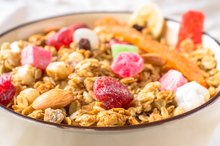Foods That Will React With Aluminum Magnesium Pans
Aluminum cookware is often less costly than stainless steel, enamelled or copper cookware, which makes it appealing for many home cooks. Aluminium magnesium pans are made from an alloy, a blend, of aluminum and magnesium, commonly sold as Magnalite. (Ref 1, 2, 4) Aluminum magnesium cookware is subject to becoming discolored or pitted over time as the pans will react with certain foods, unless it has been anodized beforehand. (Ref 1, 4) Despite popular thinking, neither aluminum nor aluminum magnesium pans will leach aluminum into foods. As well, there is no relationship between everyday aluminum use and Alzheimer’s disease according to the Alzheimer’s Association. (Ref 7)
Foods High in Salt
Either salty foods or pure salt, can cause pitting in aluminum magnesium pans, although the pitting will be less than with pure, untreated aluminum pans as an aluminum magensium alloy increases the strength of aluminum, making it a little more durable. (Ref 2, 3, 4) Salty foods that are cooked for long periods of time, as well as rock salt added to the pan with only a minimal amount of liquid, will increase the chances of pitting. (Ref 3) Because of this, gravy and salt water for cooking seafood can lead to small holes forming along the bottom and sides of your pot. Once pitting has begun, it is not recommended to continue using the pan as foods will stick to it. (Ref 1, 3)
Foods High in Acids
Effects of Inhaling Muriatic Acid Fumes
Learn More
Foods that are naturally high in acid, including dishes that have added acid, will react with the aluminum in aluminum magnesium pans, creating oxidation that causes discoloration. (Ref 4, 5) This means your pans can darken over time, especially if they are regularly exposed to high acid foods, such as lemon or lime juice, tomato products and vinegars. Foods that have been fermented to taste sour, such as kimchi, will also cause discoloration. (Ref 4, 5, 6)
Fruit Can Also Be A Problem
Some fruits, in addition to lemons and limes, are high in acids, which can also cause your aluminium magnesium pans to darken. As well, some fruits, such as apples, require acid to be added to them when cooking, increasing the acid content and the risk of discoloration. Rhubarb is a common cause of pitting in aluminum magnesium pans, as it is naturally very sour, although the finished food product is usually sweet due to added sugar. (Ref 3, 4, 6)
Benefits and Other Choices
Top 10 List of Harmful Chemical Reactions
Learn More
Aluminium magnesium pans are much harder, denser and stronger than regular aluminum pans due to the addition of magnesium. (Ref 2) Because of this, aluminum magnesium pans are more durable, while still keeping the heat conducting abilities of aluminum. (Ref 1, 2, 4, 6) To reduce the chances of pitting and discoloration, you can look for aluminum magnesium pans that have been anodized, in some cases, the cookware may simply be called anodized aluminium, as the treatment process renders the pans safe for fruits, acids and salts. (Ref 3) Anodized aluminum magnesium pans have an added film along the surface of the pan to protect the metal from reactive foods. It does not affect the heat conducting ability of the pan, although the covering may wear off over time, leading to discoloration and pitting. (Ref 3, 4)
Related Articles
References
Writer Bio
Carol Ochs is an award-winning writer in the Washington, D.C. area. During 17 years with The Associated Press she covered health, medical and sports stories as a writer, editor and producer. She has written for the health section of "The Washington Post," a Fairfax County stewardship publication and a biopharmaceutical newsletter. Ochs has a Bachelor of Science in journalism from Ohio University, Athens.









